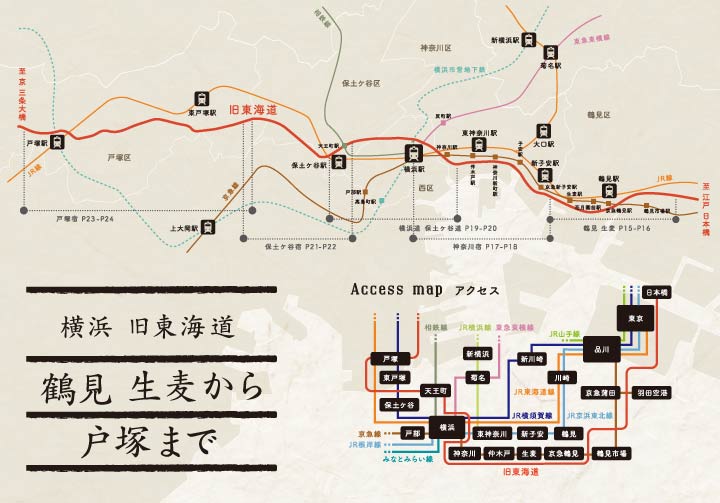- Yokohama-shi Top Page
- Sightseeing and events
- Dissemination of the appeal of Yokohama
- Initiatives to Disseminate Attractiveness
- Former Tokaido Highway
- Overview of the Former Tokaido of Yokohama
Here's the text.
Overview of the Former Tokaido of Yokohama
Last Updated November 6, 2024

How many kilometers did travelers from the Edo period walk in a day?
In general, when traveling from Edo to Kyoto, the first accommodations were Hodogaya-juku and Tozuka-juku. From Nihonbashi to Hodogaya-juku, Hachiri Kumachi (about 33 km) and Tozuka-juku is ten and a half (about 42 km), so the daily journey from Hachiri to Juri (about 32 to 40 km).
What is a post town?
The post town is also called inn and inn station, and is the base of the highway. The post office had the role of staying and resting travelers, but the most important role was to carry official luggage and communication items brought from the next post office to the next post office. .
A specialty of the old Tokaido in Yokohama City
In Tsurumi, rice buns (Yonemanju), dried plums of "Shikiraki Chaya" and ginger pickled plums. In Kanagawa-juku, black medicine, raw fish, and turtle shell rice crackers. A peony mochi was known in Sakaiki.
What was the row of trees on the highway planted for?
Namiki is said to have begun planting fruit trees on both sides of the station road in Tenpyo Hoji 3 (759) due to the performance of a monk Futeru at Todai-ji Temple, and the Edo Shogunate also ordered trees to plant trees on the highway. . Trees give travelers shade in hot summers and protect travelers from the wind and snow blowing in winter. It also served to protect the road itself from wind and rain and sunlight.
When was the old Tokaido built?
The old Tokaido was an important arterial road for east-west transportation throughout the ancient and Middle Ages. Since this road was fully developed in earnest during the Edo period, the old Tokaido generally refers to the road as one of the five highways in the Edo period. In the New Year of Keicho 6 (1601), the Shogunate issued a red seal of Ieyasu Tokugawa and a joint signature of Tadatsugu Ina, Motomasa Hikosaka, and Nagayasu Okubo to each inn on the Tokaido. Therefore, it is generally understood that with the issuance of these two documents, the inn station horseback system was established on the Tokaido, and the Tokaido in the early modern era was established.
Inquiries to this page
Public Relations Strategy and Promotion Division, City Promotion Promotion Office, Policy Management Bureau
Telephone: 045-671-3680
Telephone: 045-671-3680
Fax: 045-661-2351
Email address: ss-promotion@city.yokohama.lg.jp
Page ID: 124-962-484







